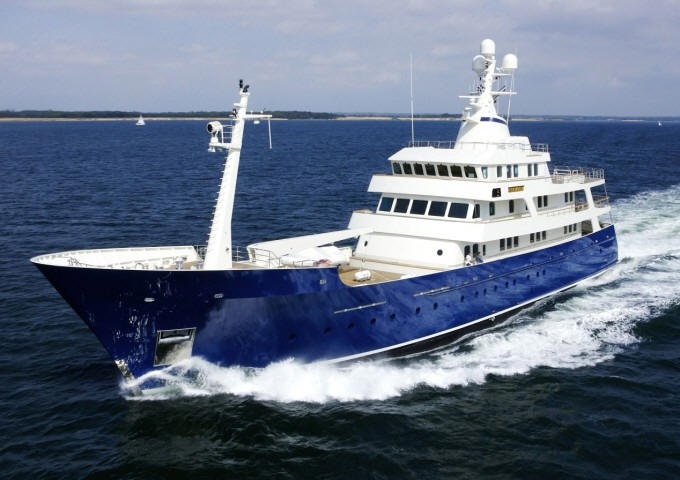
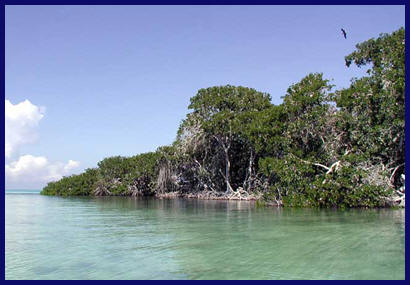 |
Well we waited and waited. February passed into March. Obviously we weren't going to get the wind we needed to head north any time soon. Other sailors shook their heads and muttered things like "Too early, wait 'til May." Half way through March we got a forecast for a short period of light winds from the north. It wouldn't let us sail North of course, but it would allow us to sail East. If we could get as far east as Los Roqués we could wait there and we'd have a much better angle for sailing north. Of course it didn't quite work, but with some judicious motoring we did manage Aves Barlovento. Just had to wait now for some moderate E or even ENE wind and we'd be off! Well wait we did. For 5 weeks! The wind just blew and blew and blew from the NE. The itinerant fishermen, were more than happy to barter, but we hadn't come supplied with many things to swap - rum and cigarettes are the principal currency. Then we bought 200 dodgy Maltese cigarettes from an Austrian sailor who stopped briefly on his way west. (Everyone going west was having a great time.) We swapped these for langostas and pargo and when we got really bored (which was often) we smoked them ourselves. Inevitably, in spite of judicious coleslaw manufacture we were beginning to run short of fresh vegetables (though we could survive for months on our tinned stores). Bill & Soon on Gaia were doing slightly better - they weren't waiting to go anywhere - they were in Aves to be in Aves and had come provisioned so to do. |
|
Then Turmoil arrived! Turmoil is a 200ft+ expedition motor yacht. Impressive is not a big enough word. Bill and I were on the VHF discussing her - "And I bet they've got vegetables!" I wryly observe. A few minutes later the VHF crackles into life again. It's Turmoil calling for the yacht interested in vegetables. I answer a little shame faced. The skipper tells us they haven't restocked since Guyana, but will be restocking in Curaçao tomorrow so if we'd like he'd speak to chef and see what they could rustle up. An hour or so later, a rib almost as big as Samarang delivered crates and crates of fresh and frozen vegetables, milk, juice, etc. These we duly shared with the other yachts. Later the skipper returned with a sizeable contribution to our beer supply and we had an opportunity to share one and learn a little of how the other half lived.
|
|
|
Finally though on 10th April we got what looked like the best weather window we were going to get, hauled anchor and set sail towards the Dominican Republic (we'd given up on a direct trip to Puerto Rico). Lumpy and the wind angle not quite what we hoped, but we were making pretty good progress, and as long as we arrive somewhere with a shop, it will be an improvement on Aves. On the second day the squalls start. Nothing too bad, just tiring continually reefing. That night the wind builds and is regularly gusting to 30+ knots. No rain, but the sea is horrible. And then in the middle of the following day during another period of strong wind, Lindy is trying to manually lock down one of the wind generators with the boat rolling. A gust takes it and the first 2 fingers of her right hand are caught by the blades. It's a horrible mess! Badly mangled. We make what repairs we can - iodine, antibiotic powder, and try and bind the fingers with steristrip, gauze and micropore to stop the bleeding and hopefully reduce opportunities for infection. The only vague contact I had in the Dominican Republic, was Frank Virgintino, the writer of the DR cruising guide - ie we'd exchanged emails once. It was worth a shot so I emailed him via HF radio. He answered almost immediately. He wasn't in the DR at the moment but he made contact with Marina Zar Par (the closest to the capital) and put me in contact with Raul the marina manager so that we could have everything possible ready when we arrived. He also gave me sailing directions and info on options if I was unable to lay Zar Par. Thirty-six hours later, at midnight, we were negotiating the shallow windy channel into Zar Par. As we approached the first pontoon the depth was dropping rapidly - I was only seeing about a foot under the keel. "How deep is the water there" I shouted to the security guard who had come out to take our lines. He dropped to his knees and stared into the dark water. Hmmm, not a high level of confidence. We aborted (I didn't want to add running aground to our list of misfortunes) and instead tied up on the unlit fuel quay. We left the sails, had a beer and went to bed. |
|
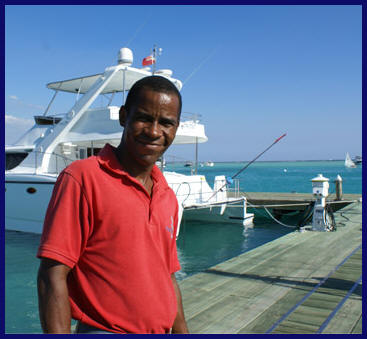 |
The following morning Raul arrived first thing to help
move the boat to a proper slip. Lindy was settled in the office
whilst I and the boat went through a lightning inspection (not lightning
enough though for Military Intelligence not to have time to ask for a
"present" - politely refused.)
And a side note here - It's important to politely refuse. We've heard of US boats who have felt obliged to give $20 to each official (sometimes up to six) at each port. You are not obliged to give anything except the official fees. Be polite, but be firm. If you give in you make it expensive for yourself and more difficult for the next boat! Once cleared we were in a car for the 1 hour drive to the hospital in Santo Domingo with Jorge who would be our regular driver for the rest of our stay in Boca Chica. The response at Plaza De Salud was excellent. Shortly after arriving at the emergency department, Lindy was taken into a cubicle and they began the process of soaking off our temporary dressings. As soon as the wounds were visible the plastic surgeon was called, and half an hour later he arrived, admission was organised and Lindy was attached to intravenous antibiotics and painkillers in preparation for surgery the following day. I was back in the taxi to collect from the boat the things Lindy would need for her stay - a trip which was to become very familiar.
|
| Now a curious thing about hospitals in the Hispanic
world is that a member of the family always stays with the patient 24x7.
A couch is generally provided in each room for them to sleep on. I
on the other hand, like any good Anglo Saxon returned to the boat once
Lindy was settled, to return the following day when she came round from
surgery. Lindy had also slept on the boat when I was in hospital in Brasil. I,
however, unwittingly became the talk of the ward. The evil uncaring
Englishman who abandoned his wife at the hospital! When I next
arrived, I was interrogated by the receptionist who seemed to have been
nominated to put right this wrong. I tried to explain that in our
country it wasn't normal or expected for visitors to stay for so long -
unless of course the patient was close to death. She listened and
nodded, but I could tell she wasn't really convinced and I could almost
sense the nurses crossing themselves as I walked past. I think the
surgeon ( who had worked in the US) sort of understood, but he was the
only one. Anyway, the operation was successful, the finger was rebuilt, the nail bed reconstructed and the bone put back in place (best not to think about it too much). Unfortunately because of infection it had been necessary to cut the palm of the hand in order to irrigate the tendon. This would make recovery slower - 80% usage in 8 weeks was the surgeon's prognosis. On the third day we were ready to leave - except.... Except the nurses wouldn't remove the drip lines from Lindy's hand until I presented a receipt from administration showing that I'd paid the bill (I had agreed to pay up front and sort things out with our insurance company later). So off to admin on the other side of the hospital. This is, of course, the day my credit card chooses to bounce - a common problem for those of us who move regularly between countries. Just need to phone the bank. The admin lady's phone is blocked for international calls. My cellphone has no coverage in this location. So off with Jorge the taxi driver to find a call centre where I can make the call and then back to the hospital to pay the bill and release Lindy from her tubes. As an aside the cost of that call to England was more than the cost of an outpatient consultation with the surgeon! |
|
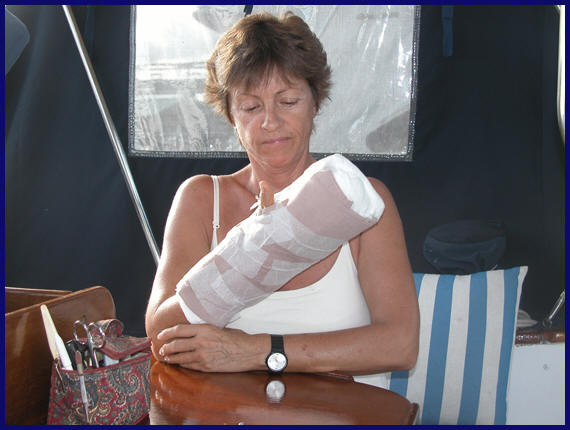 |
Back on the boat in Marina Zar Par, the next several
weeks were to be slow recuperation for Lindy interspersed with regular
visits to the hospital. On each visit the dressing would be
reduced a little more until finally it was removed, together with the
stitches. Then the
exercises started. The consultant offered us a choice. We
could make the 2 hour round trip to the hospital 3 times a week for physio, or we could buy a kilo of rice and stay on the boat. Hmmm
let's think about that for a nanosecond! The rice of course was put in a bowl to offer some resistance as Lindy moved her fingers around to increase mobility. This still required three hours a day, but not the trip to the hospital, so as well as being more convenient was considerably less likely to result in our deaths. Let me explain. Lindy and I have, between us, lived and travelled in the Far East, the Middle East, most of Europe, most of South America, North America, the Caribbean, India and Africa. We are absolutely certain, without a shadow of a doubt, that the driving in the DR is the worst we have ever experienced! It was during this period of convalescence that I made a hole in the bottom of the boat. It was only a small hole, but it was a hole and it was letting in water. Even the least nautical person will know that holes in boats are generally bad. I had been chipping out some rust in the bilges in an area I thought was inside the line of the keel. It wasn't and I chipped right through. Ooops! Still better done tied up in a marina than in mid ocean. Well Zar Par has a travel lift so all we have to do is lift the boat, cut out the rusty patch and weld in a new piece of steel. Easy peasy. No more than a days work. Wrong! |
| We draw 2.1 metres and whilst the
entrance channel to the travel lift bay carries more than that when it's
been dredged, it hasn't actually been dredged for some time. Nevertheless everyone is extremely confident that if we wait for high
water, and the wind to be in the east we should have no problem.
We will be directed to the deepest part of the channel and the work boat
will be on hand if we need a little extra muscle to get us over the bar.
Well over two days we tried 5 times. There was much good natured
enthusiasm and confidence, combined with much direction to the deep
channel - go to the left, no to the right, it's in the centre, go
faster, go slower. It didn't matter, we tried left, right and
centre. Fast and slow. With and without the work boat
pulling us.
The result was the same. You can't get a quart into a pint
pot and you can't get Samarang into the Zar Par travel lift!
And yes we did consider taking a line from the mast to tilt the boat over, but by this time it was spring tides and we were concerned that if we ever did get in, it might be some time before we could get out again and the hurricane season was approaching. So we settled for welding plates on the inside of the hull, courtesy of Chichito the local welder. Should have been simple, except Chichito wasn't allowed to plug his equipment into the marina power supply. Apparently he'd done so on a previous occasion and taken the entire site off line. Something that says a lot more about the marina's power supply than Chichito's equipment. Once he'd finished we were safe, but still gently seeping. We store a lot of stuff in our bilges so really wanted to get back to completely dry if at all possible. After two more attempts the plates had got bigger, the coat of grinding dust covering every internal surface of the boat had got thicker, but the leak continued to gently seep. At the time we first discovered that we couldn't get into the lift, and before employing Chichito, we had imported a couple of gallons of underwater epoxy from the US. Now we decided was the time to put it to use. It's wonderful stuff, every boat should have some, but a tad tricky to use underwater. You'll remember those 70s lava lamps? That's exactly how this stuff behaves except that it's not constrained by a glass container, so globules of it float off in all directions. To add to the fun it goes off extremely quickly. So it must be quickly shepherded into the required location on the hull, to which it is initially reluctant to stick and held firmly in place for the next several minutes until adhesion is achieved. In spite of the reluctance to stick to steel I can report that it adheres tenaciously and almost immediately to skin, neoprene and all forms of diving equipment. Nevertheless, after a couple of days with one-armed Lindy mixing on deck and me applying the stuff under the water we were finally dry! |
|
| It would be seven weeks in total before the doctor
gave us the OK for Lindy to sail, so we took the opportunity to see
something of the island. We hired a car, or rather we tried to
hire a car........ the high price of petrol, relative to the average wage
has had a curious effect on the Dominican psyche. Cars are always
driven with their tanks virtually empty. Whether this is because
the owner can't afford to fill it, is afraid it will be siphoned out, or
because he's simply lost the plot, it's hard to say, but even taxis
drive around with the fuel gauge hard against the empty stop and you
always keep your fingers crossed that you won't end up helping to push
it
to the next filling station. So we arrived to collect our hire car, completed the paperwork, climbed in and started the engine. Put it into drive and it stalled as soon as I tried to pull away. Started it again, put it into drive and it stalled immediately. It was clearly running on fumes. Tried to start it again - flat battery! No problem sir we'll get another one brought round. They did. It had a flat tyre. After watching one of the guys pumping manfully with the sort of pump generally seen on pushbikes and seeing no change in the shape of the tyre we decided to abort. By now we'd lost a couple of hours and we would try again tomorrow. No problem, we jumped in another car for them to run us back to the marina. We got about 100 yards when it started to misfire. He had just enough fuel to get back to the hire shop, where we transferred to another car (also with the gauge on empty I noticed).
|
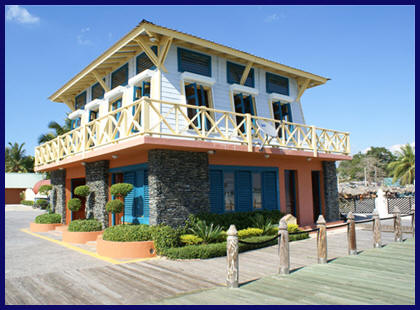 |
| Next day we were collected again and this
time all was well "and it has some fuel" I asked. "Plenty" I was
told "you should easily have enough to get to the gas station at the end
of the road". We did and we filled the tank! I half expected
that we would attract a swarm of onlookers by so doing - "Just
come and look at what the gringos are doing"! We were going to do an anti-clockwise circumnavigation of the east of the DR, returning via the Dominican Alps. The direction was dictated by the weather - we really wanted to be in the alps when it wasn't raining if at all possible and there was a chance it might stop raining briefly in a couple of days time (the commonest phrase in Lindy's diary for this period is "pissing down again"). There was interesting stuff also at the western end towards Haiti, but we'd been warned we wouldn't make it without a serious 4x4. As it was, such is the state of the roads, we had one tyre explode on us, totally disintegrated. A rear one fortunately. No probs getting it repaired though - if there's one thing the DR has plenty of it's tyre repair shops along the side of the road! |
|
| First stop was Rio San Juan and the Hotel Bahias
Blancas, which came highly recommended by the Lonely Planet, for the
views and ambience. Well I don't know when they last
visited. The views were still there, but the hotel was run down
and dirty, with piles of rubble on the veranda. The room was dark and dirty, but worst of all was the lady who met us at reception.
She and her clothes were grubby and she stank. It was too late to
find anywhere else so we stayed. The food was also predictably
awful and our hostess had neither changed nor washed when we checked out
the following morning. We had found out from her less noisome, but
equally grubby husband, who served us the night before, that they had
moved to the DR from Canada and bought the hotel some 30 years earlier
and it was now much too much for them to manage - but they couldn't
afford to return home with the small amount of money they could raise
from selling the hotel. A not uncommon story of the downside of
moving to what seems a paradise! An early start the next morning - for obvious reasons! Next stop Santiago, (strictly that's Santiago de los Caballeros - Santiago of the gentlemen) the northern capital and centre of culture (allegedly). Needless to say it was pissing down, which didn't help, but we drove round and round without really being able to identify anything which encouraged us to stop. |
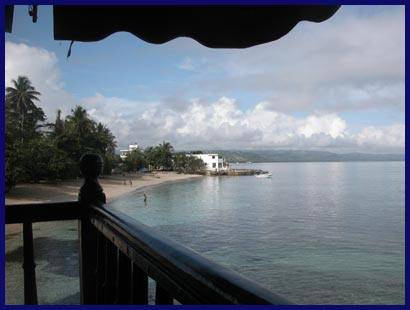 |
| The much feted cathedral was closed
for restoration and the highly recommended Museo folklórico Tomás Morel was closed. We did find the
Monument to the Heroes of the Restoration, which stands 70 meters tall
on a hilltop overlooking the city, but it was raining so hard it wasn't
worth climbing up to see the view. So with some trepidation after
our experience the night before we headed for Camp David.
Not The Camp David of course, but a very decent hill top hotel
overlooking Our final night was to be at hotel Alto Cero at Constanza in the Dominica alps. A spectacular climb up a winding alpine road to a beautiful mountain ringed valley which produces much of the fruit and vegetables which DR exports to the US and the rest of the world. It's also at 1200 metres and night time temperatures are in single figures - one of the few places in the Caribbean where one needs to wear a jumper and close the window!
|
|
 |
|
| Back on the boat it's time to rethink next steps.
Although Lindy was now cleared to sail, she was still a long way from
fully fit and we had now given up our plan to head north to the US.
With the hurricane season on the way, the long trip up through the
Bahamas and then up the east coast didn't seem the most sensible idea
with one half of the crew still incapacitated. And, high though
our confidence was in the new epoxy job, we did need to get the hole
repaired properly asap. So with a deep sigh we decided we should
head back to Curaçao. A bit soul destroying, given how hard we'd
worked to leave, but the sensible decision. The
new plan was to head east to Puerto Rico and from there, we should be
able to put the wind behind the beam for the crossing back to Curaçao.
The eastward trip could be accomplished in small steps, for a few hours
early most mornings, the land breeze cancels out the prevailing trades,
and we could take advantage of this to motor sail in short hops along
the coast. As we prepared to leave we discovered we had a house guest. A rat. Hurrah! Obviously continually finding food with teeth marks, packets bitten open and deposits of rat poo is an "inconvenience", but our biggest fear was that Ratty would start tucking into the insulation on our wiring. We've heard of boats who's electronics have been destroyed by rats. The only traps we were able to find were the "humane" sticky pads. Though why it's humane to catch a rat on a sticky pad we're not really sure. Once stuck it either starves to death or you beat it to death or you throw it over the side - still stuck - and let it drown. The one thing you're certainly not going to do is try and prise extremely pissed-off rat, with sharp teeth and claws, off it's new home so you can set it free to get on board somebody else's boat Anyway, a search of Google informed us that peanut butter was the bait of choice, so we dolloped the stuff on the pads, planted them in ratty places, set sail and waited. |
| After a few days of relaxed hops and anchoring along
the coast we tied up in Marina Capo de Campo which would be our final
stop in DR and where we would clear out. Capo de Campo is a very
upmarket marina, built as part of a luxury property development, which
boast no less than 3 world class golf courses. Sometimes
marinas like this are less than welcoming to cruising sailors, but not
so Capo de Campo. Frank Castillo, the port captain, even took the trouble to
load us into a golf buggy and give us a guided tour. Designer
stores, restaurants, bars and supermarkets bursting at the seams with imported
goods was the order of the day. A great place to spend a few days
if you could afford the prices, but, just like in Porto Chervo Sardinia,
with which it shares a designer, you can't avoid the niggling feeling
that you've arrived inadvertently on the film set for an upmarket soap. So, time to check out. The obligatory half a dozen officials trooped to the boat to perform the reams of pointless paperwork (we're treated like any other "ship"). Then, everything completed, passports stamped, zarpe delivered, etc we all sit in the cockpit looking at each other and smiling.......and smiling. "It's very hot" volunteers one of the large uniformed ladies (military intelligence perhaps?). "It is" agrees Lindy "that's why we need to get out to sea". More smiling. Finally, with a slightly despondent air, they get up one by one and leave. We've been polite, stood firm and no money has changed hands. And there are no hard feelings. "Good trip and come back soon." says an un-uniformed one as he leaves the boat and with that they all turn smile and wave. We were off to Puerto Rico. 120 miles and after motoring the first 20 miles to get us round the point we would be sailing overnight across the Mona Passage. |
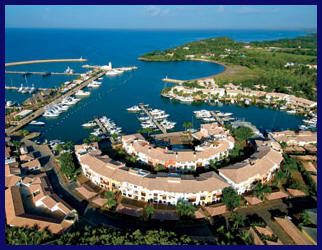 |
